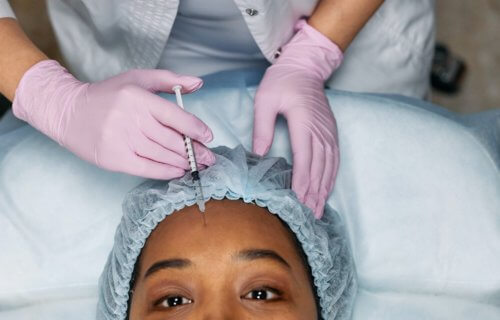CHICAGO — Serious health events like suffering a stroke or being diagnosed with cancer are, obviously, tough on the physical body. New research from Northwestern University, however, is illustrating just how tough a serious illness can be psychologically as well. Researchers report that patients with serious illnesses are turning to cosmetic procedures to look healthier and feel more comfortable in social settings.
“Patients dealing with serious illnesses have visible signs of their health problems, which make them feel unhappy about themselves,” says senior study author Dr. Murad Alam, vice chair of dermatology and chief of cutaneous and aesthetic surgery at Northwestern University Feinberg School of Medicine, in a statement. “Cosmetic procedures that improve appearance make these patients feel better and more confident during a time when they are already going through so much.”
‘It’s like you don’t even recognize yourself’
Many patients dealing with serious illnesses decide to go under the knife for various cosmetic surgeries, but this study is the first time anyone has ever asked these patients why. Ultimately, study authors conclude sick patients often seek out cosmetic procedures in an attempt to feel better both mentally and physically, and feel more comfortable in public or in social settings. These individuals don’t want to look sick to strangers and loved ones alike. They may believe a cosmetic procedure can help them “get back to normal” as quickly as possible.
More specifically, patients included in this study had experienced either a stroke, advanced melanoma, prostate cancer, advanced cervical cancer, advanced thyroid cancer, or Hodgkin’s lymphoma, among various other illnesses. The majority of participants flat out cited their major medical illness (75%) or treatment (66%) as the main motivator for their procedure.
Other common motivators shared by patients included enhancing social acceptance, counteracting aging, maintaining overall mental well-being, alleviating impact on work success, and responding to suggestions by loved ones and doctors.
‘‘I feel as though the medical treatments I’ve gone through have left me looking a little more aged, a little more tired than my peers,” comments one participant, quoted as a “54-year-old woman, with breast cancer and sagging eyelids.”
‘‘Post-treatment, you look in the mirror negative-wise,” adds a 34-year-old woman with breast cancer. “You have no hair, no eyebrows, no eyelashes, nothing. My immune system was severely low, so I looked really pale and anemic. It’s like you don’t even recognize yourself anymore.’’
Which cosmetic surgeries are patients having?
As far as cosmetic surgeries, studied patients under went various cosmetic procedures including noninvasive treatments (neurotoxin and filler injections, lasers, chemical peels, radiofrequency devices, dermabrasion and microneedling) and invasive procedures (face lifts, liposuction and eyelid lifts).
It’s worth noting the study group for this research was small, featuring only 12 patients. Each participant was interviewed one-on-one about their decision by a trained investigator. Many mentioned that the safety of noninvasive cosmetic procedures made them more attractive. Also, several participants added that they wouldn’t have gotten any surgeries without first getting the OK from both their main doctor and loved ones.
All in all, researchers conclude that most sick patients don’t rush into cosmetic procedures without first carefully thinking about it and discussing the matter with their doctor. So, they stress the importance of good communication between physician and patient. A clear line of communication is the best way to ensure the patient achieves what they want with the procedure while also staying safe.
“These findings may help improve conversations between physicians and patients who are interested in getting cosmetic procedures, so that they have information on procedures that are most safe and helpful for them,” Dr. Alam concludes.
The study is published in the Journal of the American Academy of Dermatology.
